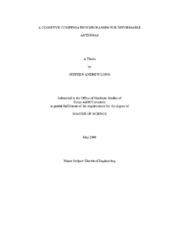| dc.contributor.advisor | Huff, Gregory H. | |
| dc.creator | Long, Stephen A. | |
| dc.date.accessioned | 2010-07-15T00:12:26Z | |
| dc.date.accessioned | 2010-07-23T21:43:53Z | |
| dc.date.available | 2010-07-15T00:12:26Z | |
| dc.date.available | 2010-07-23T21:43:53Z | |
| dc.date.created | 2009-05 | |
| dc.date.issued | 2010-07-14 | |
| dc.date.submitted | May 2009 | |
| dc.identifier.uri | https://hdl.handle.net/1969.1/ETD-TAMU-2009-05-521 | |
| dc.description.abstract | This thesis presents the design, theory, and measurement of a linearly polarized microstrip patch antenna with a novel substrate-integrated mechanism that can compensate the detuning effects from a physical deformation. Specifically, this antenna bends sharply through the center up to 90 (pivoted about the ground plane) and retuning (compensation) occurs by displacing electromagnetically functionalized colloidal dispersions (EFCDs) through a capillary in the substrate (parallel to the radiating edge). The displacement of a high permittivity EFCD by a low permittivity EFCD acts as a net length reduction (shown mathematically using perturbation theory). This mitigates the physical length extension from the deformation and stretching of the conductors. The design can be considered cognitive (conceptually in this thesis) by allowing the deformation and resulting compressive forces in the substrate to actuate displacement.
The antennas to demonstrate this concept have been chosen to operate at 3 GHz and use a Sylgard 184 (a flexible silicone-based elastomer) substrate material with a height of 4 mm. Simulations of an HFSS model demonstrate a stable VSWR 2:1 bandwidth of 141 MHz across the entire range of bending. Currently available fabrication methods and EFCD material systems provide some limitations. Therefore, proof-of-concept is provided using 2 microstrip patch antennas (one flat patch and one patch bent 90) designed using 4 mm thick Rochelle Foam substrates and rigid copper sheets. A flexible patch was fabricated using Sylgard 184 and SEC 1233 (a conductive elastomer) but bending created several tears in the material and delaminating of the flexible conductor. However, the comparison of trends between simulated and measured results show good agreement and are used to validate this compensation mechanism. | en |
| dc.format.mimetype | application/pdf | |
| dc.language.iso | eng | |
| dc.subject | EFCD, deformation, compensation, BSTO, material perturbation, polymorphic structure | en |
| dc.title | A COGNITIVE COMPENSATION MECHANSIM FOR DEFORMABLE ANTENNAS | en |
| dc.type | Book | en |
| dc.type | Thesis | en |
| thesis.degree.department | Electrical and Computer Engineering | en |
| thesis.degree.discipline | Electrical Engineering | en |
| thesis.degree.grantor | Texas A&M University | en |
| thesis.degree.name | Master of Science | en |
| thesis.degree.level | Masters | en |
| dc.contributor.committeeMember | Nevels, Robert D. | |
| dc.contributor.committeeMember | Ounaies, Zoubeida | |
| dc.contributor.committeeMember | Zourntos, Takis | |
| dc.type.genre | Electronic Thesis | en |
| dc.type.material | text | en |


